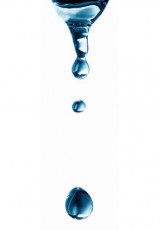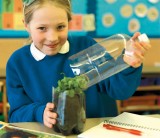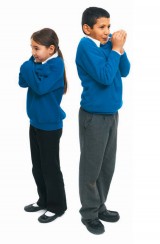Deborah Herridge use practical science to help children comprehend the vital role of water in our ecosystem...
Covering 70% of the Earth’s surface, water is one of our most plentiful resources, and yet often the scarcest. Every living thing needs it to stay alive and without the atomic pairing of hydrogen and oxygen our planet would be dry, dusty and lifeless. It is then, perhaps, surprising that water is the one resource we take completely for granted.
Using these practical science activities, children will learn to see water as a finite resource. By examining processes such as the water cycle and transpiration, they will begin to understand that it is a precious substance shared by people, animals and plants across the globe not just now but in the future also.
 How old is your water?
How old is your water?
When we run the tap and get a glass of water we tend to think of it as ‘fresh’ – but is it? Ask the children how old they think the water in their glass is. A few hours? Days? Weeks even? How about as old as the Earth itself? Although the water we drink may have fallen as rain only a few days ago, it is the same water that the dinosaurs drank, or that Christopher Columbus sailed across.
Our planet has a limited amount of water. The water doesn’t disappear, it gets used, reused and re-cycled time and time again in what we call the water cycle. The cycle has four main parts: evaporation, condensation, precipitation and collection. To help the children become familiar with this new vocabulary, set up four ‘stations’ around the school yard. The children are going to become water particles on the journey through the water cycle.
1. Things are heating up as we move to the ‘evaporation’ station where children can use swirly movements to suggest water warming, changing state from a liquid to a gas and moving freely around.
2. ‘Condensation’ is cool and here the children are getting colder, moving closer together in the cold air to form clouds.
3. At the ‘precipitation’ stage, they join together as water droplets and fall back to Earth as rain, sleet or snow.
4. Finally, at ‘collection’, they join together in rivers and oceans and the cycle starts again.
Practice moving through the cycle and perfecting your own actions at each stage until the children are confident with the cycle and the new vocabulary.
 Build your own water cycle..
Build your own water cycle..
Half fill a large, plastic fish tank or clear bowl with warm, salty water (the sea). Put an empty tea-cup in the centre of the tank so that the rim sits well above the surface of the water.
Cover the top of the tank with plastic food wrapping film and place several ice cubes in the centre of the plastic; this cold area represents clouds. You’ll see that the plastic dips down towards the cup under the weight of the ice - though it shouldn’t be allowed to touch the rim.
To encourage the salty ‘sea’water to evaporate, place the tank on a sunny windowsill. (Or for a faster result, train a couple of desk lamps on the water.)
What do you see? Droplets of clear water should gather and condense on the plastic below the ice and fall as precipitation into the cup beneath. Take a taste – hey presto, no salt!
 Do plants sweat?
Do plants sweat?
Plants take in water through their root system and lose it through their leaves in a process called transpiration. We can see this happening if we cover a branch of a shrub, tree or even a large pot plant with a plastic bag and tie it securely so that the leaves are totally encased. After a few hours, take a look at the bag; you should see that water has condensed on the inside. This is the water that the plant has lost through its leaves.
You can build a mini biosphere by cutting the top off a pop bottle about 1/3 of the way down. Half fill the base with compost, root some small plants in the soil and water.
Put the bottle back together again, re-seal with sellotape and make sure the top is screwed on. You’ll be amazed how the plants grow with barely any intervention. They can happily survive by recycling the water in the bottle.
You can measure transpiration by placing branches in a glass of water topped off with oil, which will prevent evaporation. Mark the level of the water with a pen; as the leaves transpire you will see the water level drop over the course of the day. Do the plants with the biggest leaves lose the most water – I wonder?
Pollution problems
1.4 million children die every year as a result of diseases spread through unclean water or poor sanitation. That’s 4000 every day. In many areas of the world water is so polluted by industry or poor sanitation that people are forced to drink dirty water.
With the class, you can investigate how water is purified by making a natural filter. Use scissors to cut the top off a pop bottle. Take the bottom half and with a pair of compasses, pierce some holes around the sides near to the base. Put the bottle in a bowl and begin filling it with large pebbles to a depth of about 8 cms. Then add a layer of smaller gravel, followed by a layer of coarse sand and finally a layer of fine sand.
In a jug, mix some garden compost with water and pour it into your filter. As the water passes through, the dirt and soil gets trapped in the layers. The water that comes out of the holes in the bottom should be much cleaner than the water in the jug. This shows children how water is naturally filtered as it flows through the ground.
How an your school conserve water?
In the UK, if we want clean water we just turn on a tap – easy! If we need to get rid of dirty water we flush it away or pour it down the drain. In many other parts of the world children aren’t so fortunate.
Ask pupils to research water consumption in our country and contrast it with how water is consumed in developing nations. How much water do we use? How much do we waste?
As a school, discuss if there are any ways in which you can reduce water consumption. What would our lives be like if we had only half the water we have now? Challenge the children to design a ‘desert’ garden using only those plants that require very little water to flourish.
Research the life and work of English cartoonist William Heath Robinson (1872-1944) Can the children devise a water saving invention in the style of Heath Robinson? Offer a prize for the most inventive and original!
Water Aid’s Splish Splash Flush DVD is available free to schools and youth groups. With a running time of 13 minutes, it’s perfect for use in assemblies. For your copy, please email .(JavaScript must be enabled to view this email address).
Becoming a teaching school
Ace-Heads
